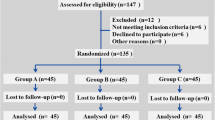Abstract
Purpose
As the blood loss after the total knee arthroplasty (TKA) is not only a potentially serious medical problem but also an economical concern, the purpose of the study was to investigate the effectiveness of different combinations of knee positioning and the applied wound dressings on blood saving after TKA.
Methods
A randomized controlled trial including 147 TKA-operated patients was conducted. The subjects were assigned to one of the four groups; Group 1—controls, Group 2—flexion, Group 3—flexion and compression, Group 4—compression. The main outcome measures of the study were the blood loss volumes during the procedure and in the intensive care rooms and the decreases in haemoglobin, haemotocrit and red blood cells on the first and the second postoperative day.
Results
The MANOVA results showed no differences between the groups in any of the observed parameters. The post-hoc comparisons of the each group to the control group also revealed no influence of any of the proposed blood saving techniques on the actual blood loss.
Conclusion
No significant differences among the four proposed blood saving methods were determined.
Similar content being viewed by others
References
Anderson LA, Engel GM, Bruckner JD, Stoddard GJ, Peters CL (2009) Reduced blood loss after total knee arthroplasty with local injection of bupivacaine and epinephirine. J Knee Surg 22:130–136
Bell TH, Berta D, Ralley F, Macdonald SJ, McCalden RW, Bourne RB, Rorabeck CH, Naudie DD (2009) Factors affecting perioperative blood loss and transfusion rates in primary total joint arthroplasty: a prospective analysis of 1642 patients. Can J Surg 52:295–301
Cao L, Ablimit N, Mantimin A, Zhang KY, Li GQ, Li G, Peng LB (2009) Comparison of no drain or with a drain after unilateral total knee arthroplasty: a prospective randomized controlled trial. Zhonghua Wai Ke Za Zhi 47(18):1390–1393
Charalambides C, Beer M, Melhuish J, Williams RJ, Cobb AG (2005) Bandaging technique after knee replacement. Acta Orthop 76:89–94
Chen LL, Wang WC, Mao XZ, Yu M, Zhu Q (2007) Evaluation and treatment of hemorrhage after hip and knee arthroplasty in the aged. Zhong Nan Da Xue Xue Bao Yi XueBan 32:316–319
Cushner FD, Friedman RJ (1991) Blood loss in total knee arthroplasty. Clin Orthop Relat Res 269:98–101
Gasparini G, Papaleo P, Pola P, Cerciello S, Pola E, Fabbriciani C (2006) Local infusion of norepinephrine reduces blood losses and need of transfusion in total knee arthroplasty. Int Orthop 30:253–256
Hewitt B, Shakespeare D (2001) Flexion vs. extension: a comparison of post-operative total knee arthroplasty mobilisation regimes. Knee 8:305–309
Kullenberg B, Ylipaa S, Soderlund K, Resch S (2006) Postoperative cryotherapy after total knee arthroplasty: a prospective study of 86 patients. J Arthroplasty 21:1175–1179
Ma T, Khan RJ, Carey Smith R, Nivbrant B, Wood DJ (2008) Effect of flexion/extension splintage post total knee arthroplasty on blood loss and range of motion—a randomised controlled trial. Knee 15:15–19
Malone KJ, Matuszak S, Mayo D, Greene P (2009) The effect of intra-articular epinephrine lavage on blood loss following total knee arthroplasty. Orthopedics 32:100
Mesa-Ramos F, Mesa-Ramos M, Maqueira-Canosa C, Carpintero P (2008) Predictors for blood transfusion following total knee arthroplasty: a prospective randomised study. Acta Orthop Belg 74:83–89
Ong SM, Taylor GJ (2003) Can knee position save blood following total knee replacement? Knee 10:81–85
Pope RO, Corcoran S, McCaul K, Howie DW (1997) Continuous passive motion after primary total knee arthroplasty. Does it offer any benefits? J Bone Joint Surg Br 79:914–917
Prasad N, Padmanabhan V, Mullaji A (2007) Blood loss in total knee arthroplasty: an analysis of risk factors. Int Orthop 31:39–44
Sehat KR, Evans RL, Newman JH (2004) Hidden blood loss following hip and knee arthroplasty. Correct management of blood loss should take sudden loss into account. J Bone Joint Surg Br 86:561–565
Speck M, Jakob R, Brinkmann KE (1999) Blood loss after total knee arthroplasty in relation to positioning: 70° flexion vs extension. J Bone Joint Surgery 81B(Suppl 11):245
Stucinskas J, Tarasevicius S, Cebatorius A, Robertsson O, Smailys A, Wingstrand H (2009) Conventional drainage versus four hour clamping drainage after total knee arthroplasty in severe osteoarthritis: a prospective, randomised trial. Int Orthop 33:1275–1278
Tai TW, Jou IM, Chang CW, Lai KA, Lin CJ, Yang CY (2010) Non-drainage is better than 4-hour clamping drainage in total knee arthroplasty. Orthopaedics 10:156–160
Conflict of interest
The authors declare that they have no conflict of interest.
Author information
Authors and Affiliations
Corresponding author
Rights and permissions
About this article
Cite this article
Madarevic, T., Tudor, A., Sestan, B. et al. Postoperative blood loss management in total knee arthroplasty: a comparison of four different methods. Knee Surg Sports Traumatol Arthrosc 19, 955–959 (2011). https://doi.org/10.1007/s00167-010-1309-8
Received:
Accepted:
Published:
Issue Date:
DOI: https://doi.org/10.1007/s00167-010-1309-8



